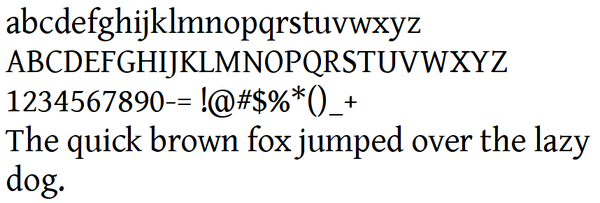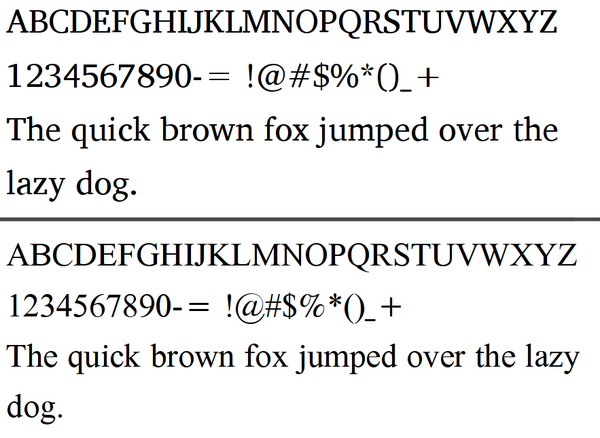How Free Software Got Its Fonts
A History of Open Source Fonts
ByWith the advent of free software for non-programmers, users ran into a licensing dilemma in a world of proprietary fonts.
Most Linux users soon hear of the influence of the GNU General Public License (GPL) in the development of free software. However, fewer have heard of the influence of the SIL Font License, although it is as important for design as the GPL has been for software. Just as the GPL is responsible for the development of free software, so the SIL Font License has enabled the rise of the free font movement, making Linux a practical choice for designers and artists. Today, it is the most popular free license for fonts, although few know its story.
Today, many distributions install with a variety of fonts, some for enabling multiple languages, and others for design. Yet, until the early years of the millennium, fonts were an afterthought in free software. Free licensed fonts were packaged in most distributions, but they were intended for on-screen display, particularly in terminals. The emphasis was on monospaced fonts – fonts whose letters all took up exactly the same space – the kind familiar at the command line. If the quality was generally poor, no one minded, because the fonts were good enough for on-screen viewing, and most people using them were developers, not designers.
Around the turn of millennium, the needs of users started to change. For one thing, Gimp had developed to the point that it could be used for professional work. Just as importantly, in July 2000, Sun Microsystems released the StarDivision code that became OpenOffice.org, and later Apache OpenOffice and LibreOffice, giving free software its first full office system. According to rumor, the StarDivision developers were told that they would have to use the Writer word processor to document their work, which meant that free software also had its first intermediate desktop publisher.
The problem was, fonts at the time were either proprietary or public domain. Obviously, proprietary fonts would be incompatible with free software, but what happened when a font was embedded in a GPL document? At the same time, font designers were concerned that, if they released their work under a free license, it might be included in collections of low-quality fonts, and their reputation might suffer as a result.
This body of issues was not covered by the GPL, then in its second version. In fact, the growing feeling was that the GPL was not suited to artistic works, which place an emphasis on authorship that is missing in most software projects. A similar perspective led to the GNU Free Documentation License in the same era.
Some of the Creative Commons licenses were more suitable for fonts, such as the Attribution-ShareAlike, but while they were an improvement over the GPL for fonts, neither they nor any other free license was ideal, either. Yet, if these concerns could be settled, free software could potentially attract a whole new body of users who were not developers.
The GPL Font Exception
One attempt to address these issues was the GPL Font Exception. Written by David Turner in 2005, the Font Exception is an optional clause at the end of the license:
“As a special exception, if you create a document which uses this font, and embed this font or unaltered portions of this font into the document, this font does not by itself cause the resulting document to be covered by the GNU General Public License. This exception does not however invalidate any other reasons why the document might be covered by the GNU General Public License. If you modify this font, you may extend this exception to your version of the font, but you are not obligated to do so. If you do not wish to do so, delete this exception statement from your version.”
In other words, the document and embedded fonts are licensed separately, and the license of one does not affect the license of the other.
The Font Exception satisfied the Free Software Foundation’s concerns, and was used by Red Hat in 2007 when it first released its Liberation Fonts, a collection of fonts that are metrically equivalent to Times New Roman, Arial, and Courier, occupying the same space as these three popular fonts, but different from them in design. However, the Font Exception did not address the concerns of font designers, so perhaps it is no accident that Google later relicensed the Liberation Fonts and released them under the Apache License 2.0, under the name CrosCore fonts. The Font Exception is still used today, but it has become a minority preference.
The Rise of SIL
Another solution was the license under which the Bitstream font family were licensed by Gnome in 2003. The Bitstream Vera License granted users “the rights to use, copy, merge, publish, distribute, and/or sell copies of the Font Software” so long as the copyright accompanied any use of the fonts. In addition, no derivative fonts could use the words “Bitstream” or “Vera” in their names and could not be sold alone.
Around the same time, SIL International, a Christian academic organization, was developing fonts to promote literacy in developing countries and to encourage the use of minority and previously unwritten languages. In 2006, Victor Gaultney, one of SIL’s designers, released Gentium, a font he had designed for his Master of Arts in Typeface Design at the University of Reading under a license inspired by the Bitstream Vera License.
Gentium is important in the history of free fonts for two reasons. First, instead of being a derivative of a proprietary font, it was an original design. Based on calligraphic designs, it is undeniably a beautiful design of unquestionable quality.

Second, its license was the first version of the SIL Font License. Revised in 2007, the SIL Font License went on to become the most popular license for free fonts. Although the requirement that a font using the license cannot be sold alone is technically a violation of the GPL, the requirement is so easy to fulfill that the SIL Font License is generally accepted as a free license. If you go to Google Fonts or the Open Font Library, and you will find that the SIL Font License is used by at least two-thirds of the available fonts.
The Legacy of SIL International
SIL International was also among the first to release fonts intended to have a complete set of Unicode characters; in fact, “Gentium” is Latin for “belonging to all nations.” One of Gentium’s notable features is long ascenders – upper strokes on letters like “b” or “h” – that give plenty of room for diacritical marks. Other fonts like Charis SIL and Doulos SIL might lack the beauty of Gentium, but their versatility set a standard for inclusion that other free font designers have strained to follow.

Additionally, SIL International developed Graphite, a smart font system that allows the use of small capitals, old-style figures, and other advanced typographical features. Graphite is supported by applications such as LibreOffice and Mozilla, but only a couple of dozen fonts are designed to use it.
Still, in as little as 10 years, SIL International and its license have transformed free software. Where once high-quality free fonts could be number on two hands, now there are hundreds. Where once Linux was not a platform for designers, now professionals can use tools like LibreOffice, Inkscape, Krita, and Scribus. Where once many doubted that font designers would care to participate in free software, today there are dozens working alone and in teams. Without SIL International and its license, undoubtedly free software would be much less developed today.
Subscribe to our Linux Newsletters
Find Linux and Open Source Jobs
Subscribe to our ADMIN Newsletters
Support Our Work
Linux Magazine content is made possible with support from readers like you. Please consider contributing when you’ve found an article to be beneficial.

News
-
Two New Distros Adopt Enlightenment
MX Moksha and AV Linux 25 join ranks with Bodhi Linux and embrace the Enlightenment desktop.
-
Solus Linux 4.8 Features Removes Python 2
Solus Linux 4.8 has been released with the latest Linux kernel, updated desktops, and a key removal.
-
Zorin OS 18 Hits over a Million Downloads
If you doubt Linux isn't gaining popularity, you only have to look at Zorin OS's download numbers.
-
TUXEDO Computers Scraps Snapdragon X1E-Based Laptop
Due to issues with a Snapdragon CPU, TUXEDO Computers has cancelled its plans to release a laptop based on this elite hardware.
-
Debian Unleashes Debian Libre Live
Debian Libre Live keeps your machine free of proprietary software.
-
Valve Announces Pending Release of Steam Machine
Shout it to the heavens: Steam Machine, powered by Linux, is set to arrive in 2026.
-
Happy Birthday, ADMIN Magazine!
ADMIN is celebrating its 15th anniversary with issue #90.
-
Another Linux Malware Discovered
Russian hackers use Hyper-V to hide malware within Linux virtual machines.
-
TUXEDO Computers Announces a New InfinityBook
TUXEDO Computers is at it again with a new InfinityBook that will meet your professional and gaming needs.
-
SUSE Dives into the Agentic AI Pool
SUSE becomes the first open source company to adopt agentic AI with SUSE Enterprise Linux 16.
